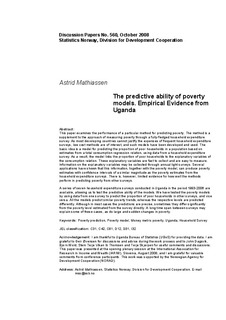| dc.description.abstract | Abstract:
This paper examines the performance of a particular method for predicting poverty. The method is a supplement to the approach of measuring poverty through a fully-fledged household expenditure survey. As most developing countries cannot justify the expenses of frequent household expenditure surveys, low cost methods are of interest, and such models have been developed and used. The basic idea is a model for predicting the proportion of poor households in a population based on estimates from a total consumption regression relation, using data from a household expenditure survey. As a result, the model links the proportion of poor households to the explanatory variables of the consumption relation. These explanatory variables are fast to collect and are easy to measure. Information on the explanatory variables may be collected through annual light surveys. Several applications have shown that this information, together with the poverty model, can produce poverty estimates with confidence intervals of a similar magnitude as the poverty estimates from the household expenditure surveys. There is, however, limited evidence for how well the methods perform in predicting poverty from other surveys. A series of seven household expenditure surveys conducted in Uganda in the period 1993-2006 are available, allowing us to test the predictive ability of the models. We have tested the poverty models by using data from one survey to predict the proportion of poor households in other surveys, and vice versa. All the models predict similar poverty trends, whereas the respective levels are predicted differently. Although in most cases the predictions are precise, sometimes they differ significantly from the poverty level estimated from the survey directly. A long time span between surveys may explain some of these cases, as do large and sudden changes in poverty.
Keywords: Poverty prediction, Poverty model, Money metric poverty, Uganda, Household Survey
JEL classification: C31, C42, C81, D12, D31, I32 | no_NO |
